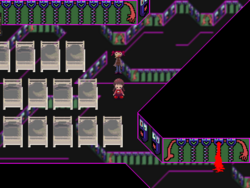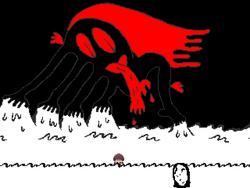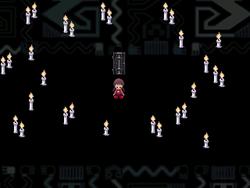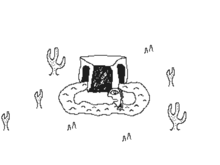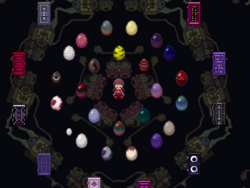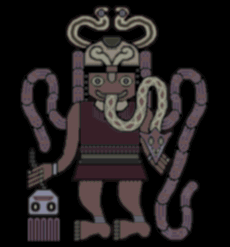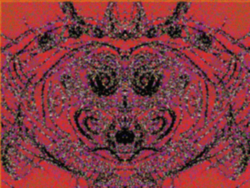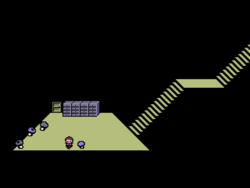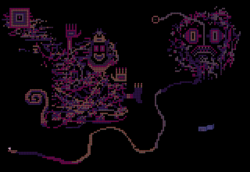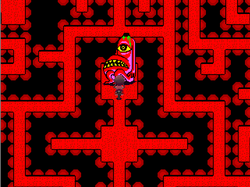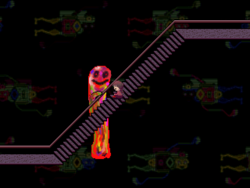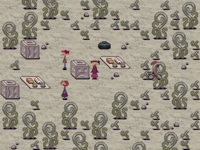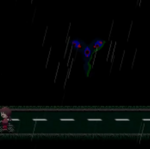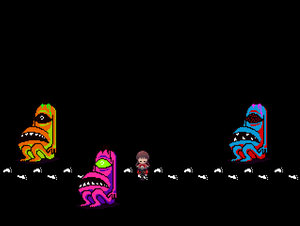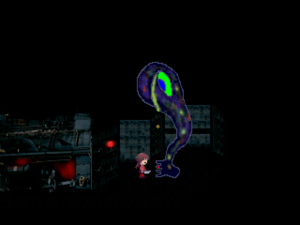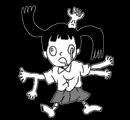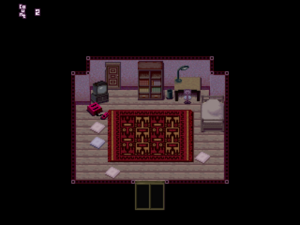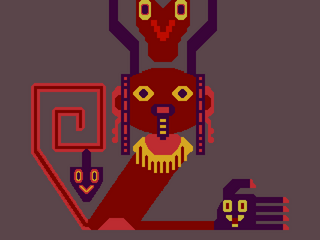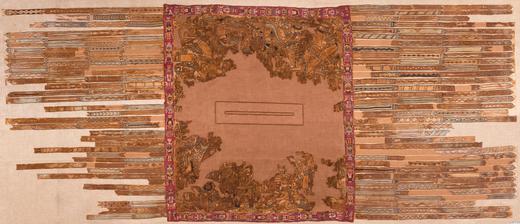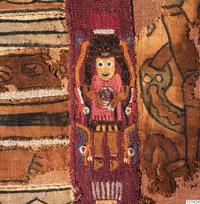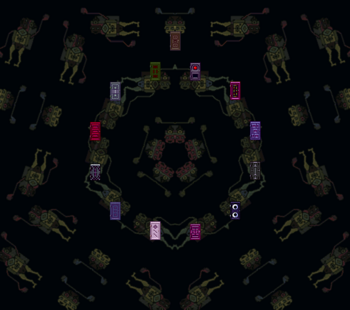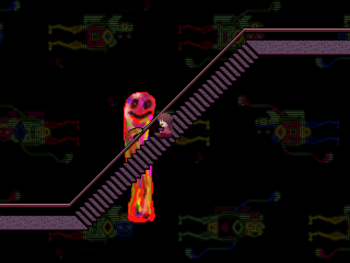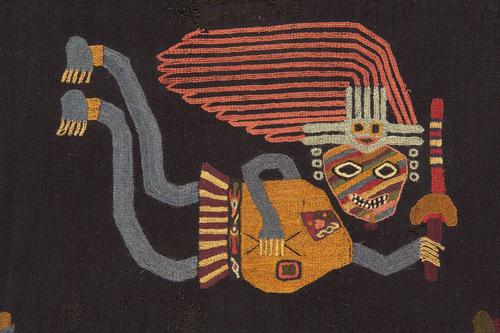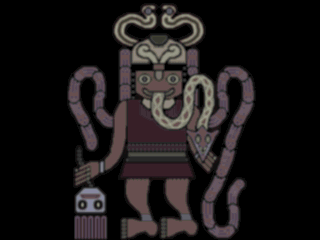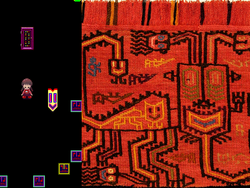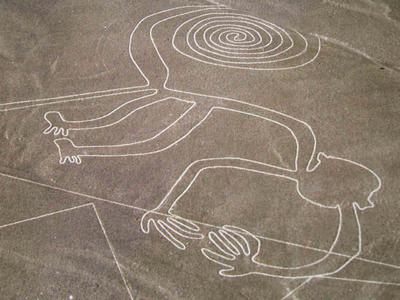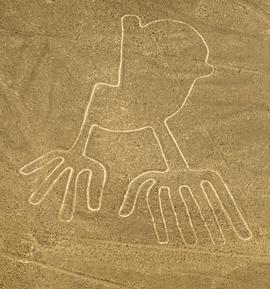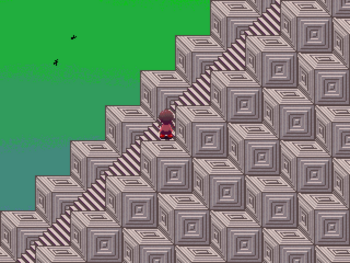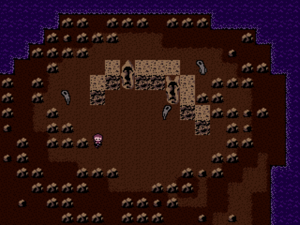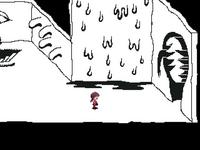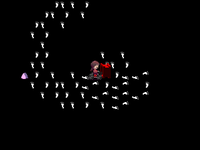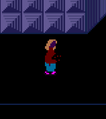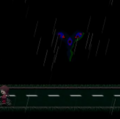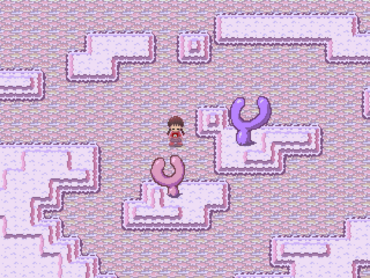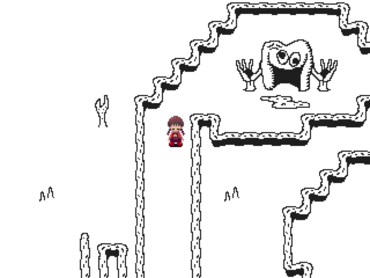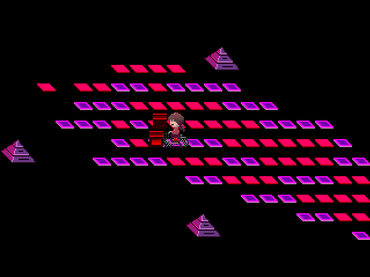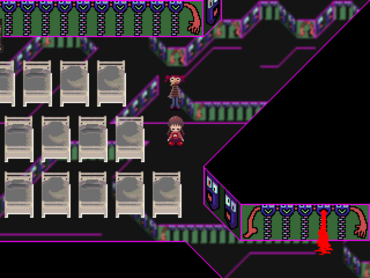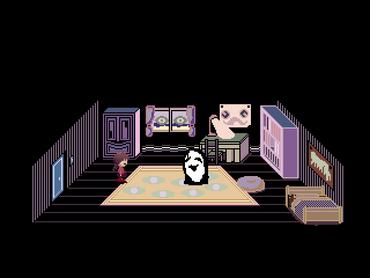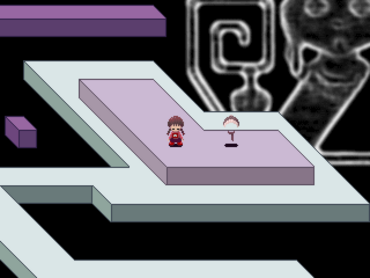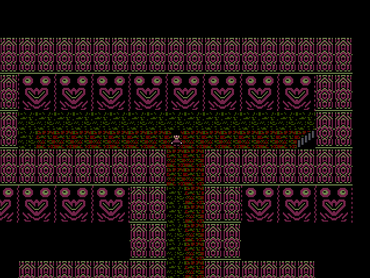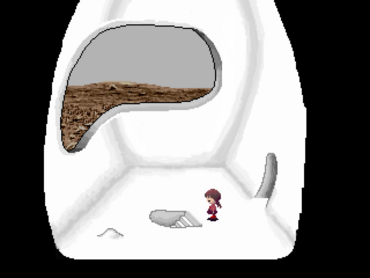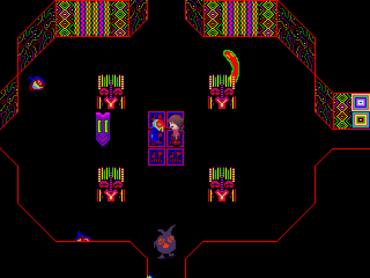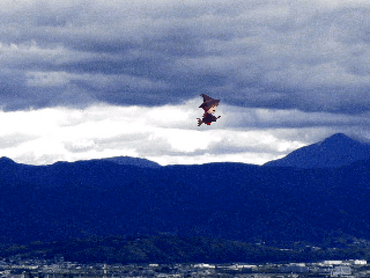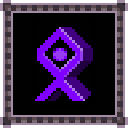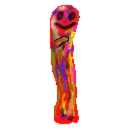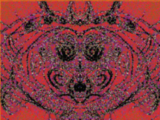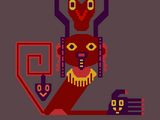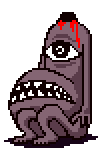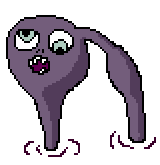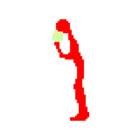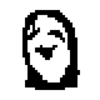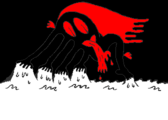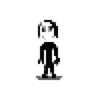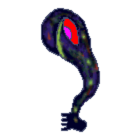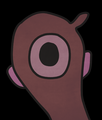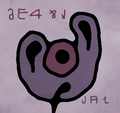The Style Guide has recently been rewritten. Please take a moment to review the new guidelines.
| Line 1,335: | Line 1,335: | ||
</div> | </div> | ||
== | ==Yume Nikki Wiki Theory Archive== | ||
This section is a partial archive of theory-related pages or sections that have been or are set to be removed from Yume Wiki with the introduction of the new [[YumeWiki:Style Guide|Style Guide]] on March 24th, 2025. | |||
As the articles are either largely written in Japanese, have broken Google- | This section is split into two sections: "Name" articles and "Theory" articles. | ||
*The Name articles were a series of articles created by Mt.kiki on the Yume Nikki Wiki on Fandom. These pages list various theories relating to ''Yume Nikki'' and possible design inspirations for various aspects of the game. As the articles are either largely written in Japanese, have broken Google-translated English, or are copy-pasted from other websites, the sections here attempt to decipher what the original articles possibly intend to communicate. This is also done to squeeze the contents of the articles into a smaller, usually multi-paragraph, state so that it can be read from a single section rather than an entire article. | |||
*The Theory articles were pages solely used for speculation about the game, typically presenting a theme and then elaborating on how it is relevant through different parts of the game. Two articles, "Indigenous Imagery" and "Theories", are lists of different themes speculated to be in the game with explanations for each, while the third article, "Monochrome", is about a singular reoccurring visual theme. | |||
Click '''Expand''' to view contents. | Click '''Expand''' to view contents. | ||
===Name Articles (WIP)=== | |||
<div class="mw-collapsible mw-collapsed"> | <div class="mw-collapsible mw-collapsed"> | ||
===[[Yume Nikki:Bed Room(name)|Bed Room]]=== | ====[[Yume Nikki:Bed Room(name)|Bed Room]]==== | ||
[[File:YN Number World Beds.png|thumb|250px]] | [[File:YN Number World Beds.png|thumb|250px]] | ||
The article makes a connection between the Number World Bed Room and "Naraka", a Buddhist term that is basically the Buddhism equivalent of Hell or purgatory. A being is usually sent to Naraka as a result of bad karma, which may relate to how the Number World Toriningen must be stabbed in order to enter Mini Hell, where a ghost of Madotsuki resides. | The article makes a connection between the Number World Bed Room and "Naraka", a Buddhist term that is basically the Buddhism equivalent of Hell or purgatory. A being is usually sent to Naraka as a result of bad karma, which may relate to how the Number World Toriningen must be stabbed in order to enter Mini Hell, where a ghost of Madotsuki resides. | ||
| Line 1,353: | Line 1,354: | ||
'''''Note from the sandbox owner:''''' Mini Hell also appears to be based on the Blood Pool Hell in Buddhism. While texts of this punishment, called the Blood Bowl Sutra, originated in China, it grew quite popular in Japan. The belief was that women who died during childbirth were sent to this blood pool as a form of punishment (which may explain the red drip effect seen in Mini Hell, and why it shares a similar appearance to the normal Hell map). This may also relate to Aztec themes seen in the game, as the Aztecs considered childbirth to be a form of battle that women faced. The Aztecs believed that women who suffered the same fate would be sent to Paradise alongside those that died in physical battle, a much more peaceful ending. | '''''Note from the sandbox owner:''''' Mini Hell also appears to be based on the Blood Pool Hell in Buddhism. While texts of this punishment, called the Blood Bowl Sutra, originated in China, it grew quite popular in Japan. The belief was that women who died during childbirth were sent to this blood pool as a form of punishment (which may explain the red drip effect seen in Mini Hell, and why it shares a similar appearance to the normal Hell map). This may also relate to Aztec themes seen in the game, as the Aztecs considered childbirth to be a form of battle that women faced. The Aztecs believed that women who suffered the same fate would be sent to Paradise alongside those that died in physical battle, a much more peaceful ending. | ||
===[[Yume Nikki:Bloody Touching Monster(name)|Bloody Touching Monster]]=== | ====[[Yume Nikki:Bloody Touching Monster(name)|Bloody Touching Monster]]==== | ||
[[File:Uboaspace.jpg|thumb|250px]] | [[File:Uboaspace.jpg|thumb|250px]] | ||
The Bloody Touching Monster may be based on the Daidarabotchi of Japanese mythology, a giant who weighed Mount Fuji and Mount Tsukuba on a great scale to see which was heavier. This is similar to how the Bloody Touching Monster is large in size and grabs onto the mountains in the background of Uboa's Trap. The picture in the article also depicts Daidarabotchi as fully black, almost shadow-like, much like the Bloody Touching Monster. | The Bloody Touching Monster may be based on the Daidarabotchi of Japanese mythology, a giant who weighed Mount Fuji and Mount Tsukuba on a great scale to see which was heavier. This is similar to how the Bloody Touching Monster is large in size and grabs onto the mountains in the background of Uboa's Trap. The picture in the article also depicts Daidarabotchi as fully black, almost shadow-like, much like the Bloody Touching Monster. | ||
| Line 1,359: | Line 1,360: | ||
The article also makes an odd connection between Myristica fragrans and bloodletting. The Bloody Touching Monster appears to have small spurts of blood coming from its arms/legs, which may allude to bloodletting. This process is a treatment for "nutmeg liver", the chronic congestion of the liver that gives it the appearance of nutmeg. The article then uses this connection between blood and nutmeg to bring up Myristica fragrans, a nutmeg tree that has yellow fruit with black and red seeds. The yellow hair may symbolize Poniko (blonde hair) and her room (yellow door and carpet) being transformed into Uboa's Trap (black and red, the same colors as the Bloody Touching Monster). | The article also makes an odd connection between Myristica fragrans and bloodletting. The Bloody Touching Monster appears to have small spurts of blood coming from its arms/legs, which may allude to bloodletting. This process is a treatment for "nutmeg liver", the chronic congestion of the liver that gives it the appearance of nutmeg. The article then uses this connection between blood and nutmeg to bring up Myristica fragrans, a nutmeg tree that has yellow fruit with black and red seeds. The yellow hair may symbolize Poniko (blonde hair) and her room (yellow door and carpet) being transformed into Uboa's Trap (black and red, the same colors as the Bloody Touching Monster). | ||
===[[Yume Nikki:Candle World(name)|Candle World]]=== | ====[[Yume Nikki:Candle World(name)|Candle World]]==== | ||
[[File:Candleworld.jpg|thumb|250px]] | [[File:Candleworld.jpg|thumb|250px]] | ||
The article first relates Candle World to The Presentation of Jesus at the Temple, which is also known as Candlemas. There are also the Twelve Great Feasts, related to the Presentation of Jesus at the Temple, which the article links to the twelve Nexus doors. It seems that each of the twelve doors in the Nexus represent an event that the Twelve Great Feasts are based on (though the article's table does not just use Nexus doors, it states other non-Nexus worlds like the Pink Sea and Sky Garden Stairway). | The article first relates Candle World to The Presentation of Jesus at the Temple, which is also known as Candlemas. There are also the Twelve Great Feasts, related to the Presentation of Jesus at the Temple, which the article links to the twelve Nexus doors. It seems that each of the twelve doors in the Nexus represent an event that the Twelve Great Feasts are based on (though the article's table does not just use Nexus doors, it states other non-Nexus worlds like the Pink Sea and Sky Garden Stairway). | ||
| Line 1,368: | Line 1,369: | ||
The last section involving the Walking Candles simply links it to wax sculptures. | The last section involving the Walking Candles simply links it to wax sculptures. | ||
{| border="1" cellpadding="3" cellspacing="0" | {| border="1" cellpadding="3" cellspacing="0" | ||
| Line 1,428: | Line 1,427: | ||
|} | |} | ||
===[[Yume Nikki:Dave Spector(name)|Dave Spector]]=== | ====[[Yume Nikki:Dave Spector(name)|Dave Spector]]==== | ||
[[File:YN Dave Spector.png|thumb|220px]] | [[File:YN Dave Spector.png|thumb|220px]] | ||
The article suspects that Dave Spector may be another instance of indigenous imagery in the game. They resemble a Nazca female effigy figure (picture viewable [https://upload.wikimedia.org/wikipedia/commons/f/f0/Nazca_-_Female_Effigy_Figure_-_Walters_2009207.jpg here]) which is made of hair, shell, and whale tooth. | The article suspects that Dave Spector may be another instance of indigenous imagery in the game. They resemble a Nazca female effigy figure (picture viewable [https://upload.wikimedia.org/wikipedia/commons/f/f0/Nazca_-_Female_Effigy_Figure_-_Walters_2009207.jpg here]) which is made of hair, shell, and whale tooth. | ||
| Line 1,434: | Line 1,433: | ||
Dave Spector is also compared to the children's game Manhunt, which is like a combination of hide & seek and tag. Madotsuki is considered "it" and Dave Spector is "tagged" by being stabbed with the Knife effect, allowing access to the Monoe and Severed Head tunnels. The "manhunt is sometimes played with teams" addition may relate to how there are two Dave Spectors. More about the White Desert and how it may be based on children's games is detailed in the White Desert's Name article. | Dave Spector is also compared to the children's game Manhunt, which is like a combination of hide & seek and tag. Madotsuki is considered "it" and Dave Spector is "tagged" by being stabbed with the Knife effect, allowing access to the Monoe and Severed Head tunnels. The "manhunt is sometimes played with teams" addition may relate to how there are two Dave Spectors. More about the White Desert and how it may be based on children's games is detailed in the White Desert's Name article. | ||
===[[Yume Nikki:Effects (name)|Effects]]=== | ====[[Yume Nikki:Effects (name)|Effects]]==== | ||
[[File:YN Effect Eggs.png|thumb|250px]] | [[File:YN Effect Eggs.png|thumb|250px]] | ||
Effects take the form of eggs when they are dropped in the Nexus. The article relates this to Easter eggs, which are special eggs given out around springtime to celebrate Easter. Eggs, which are often used to symbolize rebirth, are used in Christianity to symbolize the empty tomb of Jesus of which he was resurrected from. This could relate to the ending of the game, as many fans view Madotsuki's death as a "rebirth" or "reawakening", and the only way to achieve the ending is through dropping all of the effects (eggs) in the Nexus. The Name article also relates the time that Easter eggs are given out (spring) to a section in the Wilderness article detailing Batsu's similarity to the Asian royal fern, which sprouts in the spring. Batsu also resembles a spiral shape, which is noticed in the Wilderness Name article. In some ancient civilizations, spirals are regarded as a symbol for the cycle of life and death, which could also relate to the "reawakening" ending theory. | Effects take the form of eggs when they are dropped in the Nexus. The article relates this to Easter eggs, which are special eggs given out around springtime to celebrate Easter. Eggs, which are often used to symbolize rebirth, are used in Christianity to symbolize the empty tomb of Jesus of which he was resurrected from. This could relate to the ending of the game, as many fans view Madotsuki's death as a "rebirth" or "reawakening", and the only way to achieve the ending is through dropping all of the effects (eggs) in the Nexus. The Name article also relates the time that Easter eggs are given out (spring) to a section in the Wilderness article detailing Batsu's similarity to the Asian royal fern, which sprouts in the spring. Batsu also resembles a spiral shape, which is noticed in the Wilderness Name article. In some ancient civilizations, spirals are regarded as a symbol for the cycle of life and death, which could also relate to the "reawakening" ending theory. | ||
| Line 1,455: | Line 1,454: | ||
|} | |} | ||
Another Fabergé egg that is brought up is the Bouquet of Lilies Clock egg, which has | Another Fabergé egg that is brought up is the Bouquet of Lilies Clock egg, which has Roman numerals up to twelve surrounding it. The egg is also split into 12 sections. Notably, there are also twelve doors in the Nexus (excluding Madotsuki's door). The lilies may have also inspired the presence of the white lilies in the Crossover Garden. White lilies are also associated with death in Japanese culture, which may allude to the ending, which requires leaving the effect eggs. | ||
The final parts of the article relate to the ending, resurrection, and the directions that two events in the game symbolize. The article first mentions the Feast of the Ascension, a feast meant to commemorate the ascension of Jesus that usually takes place during Eastertide. There are two different events | The final parts of the article relate to the ending, resurrection, and the directions that two events in the game symbolize. The article first mentions the Feast of the Ascension, a feast meant to commemorate the ascension of Jesus that usually takes place during Eastertide. There are two different events that the article associates with "ascension": the Witch's Flight and the Ending. The Name article also relates this to the cycle of the Sun and Moon, and how they could symbolize positivity and negativity, respectively: | ||
*The Sun rises in the east, symbolizing brightness/positivity/good. The Witch's Flight, which is a happier event compared to a lot of what happens in the game, could symbolize this positivity. It should be noted that when Madotsuki has her effects, she travels East and has a more positive experience. When you fall from the event by unequipping the effect, Madotsuki wakes up while facing east, which could relate to the resurrection (waking up) and Christ ('''East'''er). | *The Sun rises in the east, symbolizing brightness/positivity/good. The Witch's Flight, which is a happier event compared to a lot of what happens in the game, could symbolize this positivity. It should be noted that when Madotsuki has her effects, she travels East and has a more positive experience. When you fall from the event by unequipping the effect, Madotsuki wakes up while facing east, which could relate to the resurrection (waking up) and Christ ('''East'''er). | ||
*The Sun sets in the west, symbolizing darkness/negativity/bad. The Ending, which is a more negative experience and literal ending of Madotsuki's life, could symbolize this negativity. It should be noted that when Madotsuki does not have her effects, she jumps West and has a more negative experience. | *The Sun sets in the west, symbolizing darkness/negativity/bad. The Ending, which is a more negative experience and literal ending of Madotsuki's life, could symbolize this negativity. It should be noted that when Madotsuki does not have her effects, she jumps West and has a more negative experience. | ||
===[[Yume Nikki:Eyeball World(name)|Eyeball World]]=== | ====[[Yume Nikki:Eyeball World(name)|Eyeball World]]==== | ||
[[File:Eyeball.png|thumb|250px]] | [[File:Eyeball.png|thumb|250px]] | ||
The Medamaude NPC that gives the Medamaude effect resembles the hamsa, a palm-shaped amulet depicting an open right hand with an eye on the palm. The sign represents protection, which could relate to how the Medamaude effect returns Madotsuki to the peaceful Nexus while remaining asleep, especially in a situation where she is lost or trapped by characters such as Uboa or the Toriningen. | The Medamaude NPC that gives the Medamaude effect resembles the hamsa, a palm-shaped amulet depicting an open right hand with an eye on the palm. The sign represents protection, which could relate to how the Medamaude effect returns Madotsuki to the peaceful Nexus while remaining asleep, especially in a situation where she is lost or trapped by characters such as Uboa or the Toriningen. | ||
| Line 1,469: | Line 1,468: | ||
While the background obviously takes inspiration from the Paracas, it may also be inspired by the Native American sun dance ritual. One of the members of the dance wears a red loincloth with no upper-body wear, face paint, a packet of tobacco around their neck, and sage rings around their head and wrists. This description slightly fits the Eyeball World background, as it wears red, has rings around its wrists (and ankles), and also some sort of neck attachment. The sun dancer also holds an eagle bone flute in their mouth during the sun dance, blowing it in order to attract eagles. It was considered good luck if eagles flew down due to the flute's sound, as they were considered the ''eyes'' of the heavens. | While the background obviously takes inspiration from the Paracas, it may also be inspired by the Native American sun dance ritual. One of the members of the dance wears a red loincloth with no upper-body wear, face paint, a packet of tobacco around their neck, and sage rings around their head and wrists. This description slightly fits the Eyeball World background, as it wears red, has rings around its wrists (and ankles), and also some sort of neck attachment. The sun dancer also holds an eagle bone flute in their mouth during the sun dance, blowing it in order to attract eagles. It was considered good luck if eagles flew down due to the flute's sound, as they were considered the ''eyes'' of the heavens. | ||
===[[Yume Nikki:FACE(name)|FACE]]=== | ====[[Yume Nikki:FACE(name)|FACE]]==== | ||
[[File:YN FACE.png|thumb|250px]] | [[File:YN FACE.png|thumb|250px]] | ||
FACE resembles various drawings and paintings by the artist Louis Wain, who particularly drew cats. Some of his later works depicted more surreal and abstract representations of cat faces. | FACE resembles various drawings and paintings by the artist Louis Wain, who particularly drew cats. Some of his later works depicted more surreal and abstract representations of cat faces. | ||
| Line 1,475: | Line 1,474: | ||
The Name article relates FACE's connection to Louis Wain's works to the Cat effect, suggesting that the two may have a connection. Due to these similarities, it suggests that FACE may be an interpretation of someone in Madotsuki's life, possibly a family member or her parents. | The Name article relates FACE's connection to Louis Wain's works to the Cat effect, suggesting that the two may have a connection. Due to these similarities, it suggests that FACE may be an interpretation of someone in Madotsuki's life, possibly a family member or her parents. | ||
===[[Yume Nikki:FC World(name)|FC House]]=== | ====[[Yume Nikki:FC World(name)|FC House]]==== | ||
[[File:Screenshot (9).png|thumb|250px]] | [[File:Screenshot (9).png|thumb|250px]] | ||
FC World obviously takes inspiration from classic Famicom/NES games, though ''Mother'' (also known as ''EarthBound Beginnings'') appears to be one of the more significant and obvious inspirations. | FC World obviously takes inspiration from classic Famicom/NES games, though ''Mother'' (also known as ''EarthBound Beginnings'') appears to be one of the more significant and obvious inspirations. | ||
| Line 1,485: | Line 1,484: | ||
The inclusion of the Goblins in the basement appears to interpret them as computer viruses in the article. Their brighter appearance and them wielding weapons may indicate they are intended to represent this. They also have a noticeably higher chance of giving Yen, which may indicate that eradicating them is good because they are "evil" or "bad". The castle wall they find themselves by may be intended to be a pun on a firewall, a network system intended to keep a network secure. | The inclusion of the Goblins in the basement appears to interpret them as computer viruses in the article. Their brighter appearance and them wielding weapons may indicate they are intended to represent this. They also have a noticeably higher chance of giving Yen, which may indicate that eradicating them is good because they are "evil" or "bad". The castle wall they find themselves by may be intended to be a pun on a firewall, a network system intended to keep a network secure. | ||
===[[Yume Nikki:Graffiti World(name)|Graffiti World]]=== | ====[[Yume Nikki:Graffiti World(name)|Graffiti World]]==== | ||
[[File:Graffiti World.png|thumb|250px]] | [[File:Graffiti World.png|thumb|250px]] | ||
Graffiti World's tile-like layout appears to be inspired by the game ''LSD: Dream Emulator'', which is based on a dream journal kept by Hiroko Nishikawa. The game has a similar feel to ''Yume Nikki'', relying on dream-like visuals and player exploration. This inspiration may be why the Bicycle effect can be found here, as "LSD" is also a drug. The first recorded LSD trip is known as "Bicycle Day" where Swiss chemist Dr. Albert Hofmann ingested the substance and reported intense perception changes. His assistant helped escort him out, and the two rode on bicycles in order for Hofmann to reach his house. | Graffiti World's tile-like layout appears to be inspired by the game ''LSD: Dream Emulator'', which is based on a dream journal kept by Hiroko Nishikawa. The game has a similar feel to ''Yume Nikki'', relying on dream-like visuals and player exploration. This inspiration may be why the Bicycle effect can be found here, as "LSD" is also a drug. The first recorded LSD trip is known as "Bicycle Day" where Swiss chemist Dr. Albert Hofmann ingested the substance and reported intense perception changes. His assistant helped escort him out, and the two rode on bicycles in order for Hofmann to reach his house. | ||
| Line 1,495: | Line 1,494: | ||
Graffiti World overall also seems to be based on chakra, which are vital points associated with a person's life force. The colorful tiles can be compared to the seven rainbow chakras and chakra is also a part of Buddhism (see mudrā section), though Buddhist texts usually only refer to five chakras. The name "chakra" also means "wheel" or "cycle", which may be another explanation for why the Bicycle effect can be found here. | Graffiti World overall also seems to be based on chakra, which are vital points associated with a person's life force. The colorful tiles can be compared to the seven rainbow chakras and chakra is also a part of Buddhism (see mudrā section), though Buddhist texts usually only refer to five chakras. The name "chakra" also means "wheel" or "cycle", which may be another explanation for why the Bicycle effect can be found here. | ||
===[[Yume Nikki:Hell(name)|Hell]]=== | ====[[Yume Nikki:Hell(name)|Hell]]==== | ||
[[File:Hellhenkei.png|thumb|250px]] | [[File:Hellhenkei.png|thumb|250px]] | ||
The maze-like structure of Hell appears to be inspired by the "Man in Maze" symbol created by the Papago Indians of Arizona. Though interpretations of the symbol vary between families, the general consensus is that it represents life, death, and the afterlife. The man in the symbol represents life and the center of death while the maze represents the various choices made during life. The symbol also correlates to I'itoi bring people to the earth from the underworld. | The maze-like structure of Hell appears to be inspired by the "Man in Maze" symbol created by the Papago Indians of Arizona. Though interpretations of the symbol vary between families, the general consensus is that it represents life, death, and the afterlife. The man in the symbol represents life and the center of death while the maze represents the various choices made during life. The symbol also correlates to I'itoi bring people to the earth from the underworld. | ||
| Line 1,505: | Line 1,504: | ||
The staircase leading to the Docks and the gate leading to the Dense Woods may refer to punishments in the lowest layer of Hell in Buddhism. There are areas of boiling hot water (The Docks) and trees made of sword blades that must be climbed (Dense Woods). | The staircase leading to the Docks and the gate leading to the Dense Woods may refer to punishments in the lowest layer of Hell in Buddhism. There are areas of boiling hot water (The Docks) and trees made of sword blades that must be climbed (Dense Woods). | ||
===[[Yume Nikki:KyuuKyuu-kun(name)|KyuuKyuu-kun]]=== | ====[[Yume Nikki:KyuuKyuu-kun(name)|KyuuKyuu-kun]]==== | ||
[[File:Kyukyu.png|thumb|250px]] | [[File:Kyukyu.png|thumb|250px]] | ||
The article first compares the landscape in which KyuuKyuu-kun is found, the Number World Stairway, to Diyu. This is essentially what hell in Chinese mythology is called. Within East Asian Buddhism, the color of Diyu is described as pure black, which is an accumulation of the colors of those inhabiting Diyu: the red color of hungry spirits, the yellow color of animals, and the blue color of asura (demigods or titans). These same three colors are also commonly used for oni/demons in Japanese mythology. The overall comparison with these colors if to the "flying man" figures in the background of the area, which sport the same three colors (with the addition of green). | The article first compares the landscape in which KyuuKyuu-kun is found, the Number World Stairway, to Diyu. This is essentially what hell in Chinese mythology is called. Within East Asian Buddhism, the color of Diyu is described as pure black, which is an accumulation of the colors of those inhabiting Diyu: the red color of hungry spirits, the yellow color of animals, and the blue color of asura (demigods or titans). These same three colors are also commonly used for oni/demons in Japanese mythology. The overall comparison with these colors if to the "flying man" figures in the background of the area, which sport the same three colors (with the addition of green). | ||
(TO BE COMPLETED) | (TO BE COMPLETED) | ||
</div> | |||
===Theories Article=== | |||
<div class="mw-collapsible mw-collapsed"> | |||
''[[Yume Nikki:Yume Nikki|Yume Nikki]]'' is a strange game that has no dialogue and a unique art style. The creator of the game, [[Yume Nikki:KIKIYAMA|KIKIYAMA]], [http://www3.nns.ne.jp/pri/tk-mto/kikiyamaHP.html stated on their website] that the game is meant to be an exploring game with a "dark atmosphere" but without plot or purpose. Still, there are themes in ''Yume Nikki'' that fans collected to create different theories about the characters and locations. Those themes and theories are displayed here. | |||
It should also be noted that, due to the nature of dreams, the imagery and events in the game can be considered completely random and could serve no significant purpose other than being dream-like, thus were not meant for analysis. However, due to the many branching themes that fans have found, it's also possible that these could be intentional and that separate themes could even be linked into one theorized story. Considering that multiple themes and theories can be linked to just one aspect of [[Yume Nikki:Madotsuki|Madotsuki's]] dreams, it's possible for many different interpretations to come out of one aspect of the game. | |||
A theory unique to a character, such as them being a possible reference to something or having a specific theme, may also be found in the '''Trivia''' or '''Theories''' section of their respective character pages. | |||
''Also see: [[Yume Nikki:Indigenous Imagery|Indigenous Imagery]], [[Yume Nikki:Monochrome|Monochrome]]'' | |||
{{spoiler}} | |||
==Themes of Isolation== | |||
Madotsuki does not leave [[Yume Nikki:Madotsuki's Room|her apartment]] for the entirety of the game. Going outside to her balcony at different points in the game reveals that quite a bit of time passes - it turns nighttime, then daytime again. When the door in the real world is interacted with, she shakes her head, making it impossible to exit the room. In her dream world, she can not only leave through said door but is able to access the different dream locations through similar-looking doors in the [[Yume Nikki:Nexus|Nexus]]. | |||
In her dream world, the themes of isolation and loneliness continue. There is no dialogue, most [[Yume Nikki:List of Characters|NPCs]] ignore Madotsuki, and only a few NPCs turn to her when the player tries to interact with them. One example is the [[Yume Nikki:Mall Shoppers|shoppers]] in the [[Yume Nikki:Mall|Mall]], who run away from Madotsuki and become deformed upon interaction, making an odd sound as they go away. The locations themselves can feel isolating and lonely, due to being large and often looping, especially in locations close to The Nexus, of which only contain few points of interest. The sombre soundtrack of the game is also a contributing factor within this: with most other video games, longer pieces of music (around the typical two to three minutes) can signify how much time has passed since the player started playing the game, but shorter ones can make time be lost easily. | |||
[[File:Toriningenparty.png|thumb|left|200px|Three girls having fun.]] | |||
Throughout the game Madotsuki encounters tall creatures (referred to as [[Yume Nikki:Toriningen|Toriningen]] by fans), of which are considered enemies in the game due to their nature of trapping Madotsuki in inescapable locations when in a "lunatic" state. They also have the characteristic of having a group dynamic that goes beyond other multiple identical NPCs spawning in one location (such as the [[Yume Nikki:Wheelies|Wheelies]]). The most significant example of this is the [[Yume Nikki:Events#Toriningen Party|Toriningen Party]], where a group of Toriningen are seen having a picnic together in the [[Yume Nikki:Wilderness|Wilderness]], while dancing to cheerful music. This party cannot be accessed, as the plants of the Wilderness hinder Madotsuki from approaching any closer. It is notable that the NPCs of which that are thought to be the enemies of the game act as a team while Madotsuki herself is a sole figure. | |||
Furthermore, there are other characters that also seem isolated from their surroundings: | |||
[[File:Poniko's room.PNG|thumb|right|200px|Poniko, another character isolated in their room.]] | |||
*[[Yume Nikki:Poniko|Poniko]], who is the only character in the [[Yume Nikki:Pink Sea|Pink Sea]]. Just like Madotsuki, she never leaves her room of which she seems to be the only inhabitant. | |||
*[[Yume Nikki:Mafurako|Mafurako]], who is the only NPC roaming around the expansive [[Yume Nikki:Block World|Block World]], and prefers to teleport to a random spot far away from Madotsuki when teleporting her back, with the exception of Madotsuki being in her snowman form, which makes Mafurako always teleport next to her. Mafurako is also always invisible, save for their hat and scarf, which could mean they don't want to be seen by others for some reason. | |||
*[[Yume Nikki:Mars-san|Mars-san]], who can be found in the underground area of [[Yume Nikki:Mars|Mars]], which can only be reached by crashing a spaceship into Mars and then using an effect to access the tiny hole to the underground. This exit compared to the size of the character themselves makes them seem trapped, as it is impossible for even Madotsuki to enter if she is her normal size. | |||
The various doors in The Nexus could allude to her having the desire to explore, but is unable to do so in the real world and thus feels comfortable to do it in her dreams. The Toriningen could possibly symbolize people in the real world, especially a "popular girl" figure as they are taller than Madotsuki and wear more stylish clothing and hairstyles, while their hostile nature when in their "lunatic" form could also possibly symbolize Madotsuki being bullied in the real world, resulting in her isolating herself. Mars-san could also entirely represent Madotsuki's feelings of staying inside her apartment: the feeling of being completely trapped and unable to escape. Another important encounter in the dream world that may point to a theme of isolation is [[Yume Nikki:Closet Madotsuki|Closet Madotsuki]], a sleeping Madotsuki hidden in a closet in the [[Yume Nikki:Checkered Tile Path|Checkered Tile Path]]. | |||
Relating to this theory may be the [[Wikipedia:Hikikomori|hikikomori]] phenomenon, in which reclusive teens or adults abandon social life completely in favor of staying inside. | |||
==Themes of Anxiety== | |||
[[File:Floyag_watching_Madotsuki.PNG|150px|thumb|A [[Yume Nikki:Floyag|Floyag]] following Madotsuki with its eyes.]] | |||
The theme of being watched seems prevalent in Madotsuki's dream, especially with the theme of eyes appearing throughout the dream world. This can obviously be seen in the [[Yume Nikki:Eyeball World|Eyeball World]], but also appears in the [[Yume Nikki:Dark Woods|Dark Woods]] and [[Yume Nikki:Barracks Settlement|Barracks Settlement]] with the presence of [[Yume Nikki:Isee|Isee]] and in [[Yume Nikki:White Desert A|White Desert A]] with the presence of [[Yume Nikki:Eye People|Eye People]]. Some other characters with large, singular eyes also appear such as Mars-san. Scattered eyes also appear in different [[Yume Nikki:Events|events]] such as the ああああああああ and Uboa events. | |||
Hands are also scattered throughout the game. Again, the aforementioned Eyeball World is filled with grabbing hands sprouting from the ground. Many locations also have hands or hand-like imagery: | |||
*[[Yume Nikki:Staircase of Hands|Staircase of Hands]] is filled with hands emerging from below the stairway. | |||
*[[Yume Nikki:Dark World|Dark World]] has a pair of symbols that resemble two hands. | |||
*[[Yume Nikki:Graffiti World|Graffiti World]] has a large design of a monkey-like creature clearly showing its hands. | |||
*The [[Yume Nikki:White Desert|White Desert]] has some sections with large hands and legs. [[Yume Nikki:Monoko|Monoko]] and [[Yume Nikki:The Thing with the Quivering Jaw|The Thing with the Quivering Jaw]] also have extra arms sprouting from them. The gate that leads to Block World from the White Desert also has a pair of grasping hands. | |||
**[[Yume Nikki:Poniko's House#Uboa's Trap|Uboa's Trap]], a subsection of the White Desert that [[Yume Nikki:Uboa|Uboa]] teleports the player to, has a nightmarish landscape where [[Yume Nikki:Bloody Touching Monster|a monster with multiple hands]] grasps hills in the background. | |||
*[[Yume Nikki:FC World B|FC World B]] has a dirt path design that resembles a pair of hands, one of which holds the entrance to the FC Ruins. | |||
[[File:Organoid_teleport.gif|right|thumb|150px|Organoid teleporting away.]] | |||
The implication may be that Madotsuki dislikes being touched and prefers a great amount of personal space. | |||
Themes of social avoidance may also be present, as seen in several NPCs. Characters such as [[Yume Nikki:Organoid|Organoid]] and [[Yume Nikki:Monoe|Monoe]] teleport away from Madotsuki when attempting to interact with them. Other characters, such as [[Yume Nikki:Nekoin|Nekoin]], [[Yume Nikki:Fleebie|Fleebie]], and the [[Yume Nikki:Dwarf|Dwarf]] swiftly move about, making them difficult for Madotsuki to interact with despite them all holding useful effects. Additionally, some characters, such as the [[Yume Nikki:Train Passengers|Train Passengers]], appear to grow angry when Madotsuki attempts to bring them close to her with the Cat effect. | |||
==Body Themes== | |||
In ''Yume Nikki'', it is common for NPCs or backgrounds to resemble body parts or inner organs. Also see the Themes of Anxiety theory above for more instances of body parts, particularly eyes and hands, appearing in the game. | |||
Eyeball World is filled with various [[Yume Nikki:Body Parts|NPCs]] that resemble parts of the human body, ranging from legs to lips. The [[Yume Nikki:Mouth Monsters|Mouth Monsters]], which have large mouths, give hair-related effects. [[Yume Nikki:Floyag|Uteri-shaped creatures]] also appear on the [[Yume Nikki:Infinite Road|Infinite Road]]. Furthermore, some fans suggest that [[Yume Nikki:KyuuKyuu-kun|KyuuKyuu-kun]], a large colorful worm-shaped creature who is seen rubbing the handrail of a stairway, is phallic imagery, as the character can only be seen by entering through a [[Yume Nikki:Zippertile|Zippertile]] on the wall, which can be interpreted as a pants fly. | |||
[[File:Yn_char_masada.png|thumb|right]] | |||
Another prominent body-related theme found in the game is the various strabismic NPCs ([[Wikipedia:Strabismus|strabismus]] meaning to be unable or having problems with fixating both eyes on one point at the same time, leading to the eyes not being aligned). One of the most well known strabismic characters in ''Yume Nikki'' is [[Yume Nikki:Seccom Masada-sensei|Seccom Masada-sensei]]. There could be two main reasons for their appearance: | |||
*Madotsuki herself could be strabismic but is hiding it by keeping her eyes closed. There are some structures (such as those in the [[Yume Nikki:Pink Sea|Pink Sea]] and [[Yume Nikki:Barracks Settlement|Barracks Settlement]]) and characters (such as the [[Yume Nikki:Ghostmen|Ghostmen]]) who slightly resemble chromosomes, which could mean Madotsuki inherited strabismus genetically. | |||
*Another cause of strabismic eyes is through severe brain or head injuries. It should be noted that some strabismic NPCs, notably [[Yume Nikki:Dropfish|Dropfish]], the [[Yume Nikki:Goppa|Goppa]], the [[Yume Nikki:Severed Blue Head|Severed Blue Head]], and Monoko (when shown during her [[Yume Nikki:Events#Monoko|event]]) are all strabismic while also seemingly drooling or coughing up blood. It's possible that this links to the themes of violence and traffic accidents found throughout the game (read below sections). | |||
[[File:Henkei2.png|thumb|right|Their appearance could be interpreted as either fat or pregnant.]] | |||
One particular theme relating to the body that seems to appear throughout the game is the theme of pregnancy or childbirth. [[Yume Nikki:Takofuusen|Takofuusen]] is an easily identifiable example of this, as it resembles a fetus with the "[[Wikipedia:Twin reversed arterial perfusion|TRAP sequence]]" birth defect. Other characters, such as [[Yume Nikki:Onsen-san|Onsen-san]] and [[Yume Nikki:Manhole-sama|Manhole-sama]], have cord-like appendages that resemble umbilical cords. Alongside this, characters such as the [[Yume Nikki:Henkei Shita|Henkei Shita]] have large stomachs with thin mouths resembling a surgical cut, which is a trait shared with some of the Mall Shoppers (most notably Obasan) when they distort. The theme of pregnancy could also be an explanation for the instances of characters or structures resembling reproductive organs, characters of which appear to prelude or lead to larger or more terrifying characters in the dream world, such as the Floyag and Manhole-sama eventually leading to the Thing with the Quivering Jaw and the Zippertile and KyuuKyuu-kun leading to FACE, which possibly intend to paint such themes as horrific. These instances have been largely debated by fans on what their possible meaning could be, if any. | |||
The reoccurring theme of body parts throughout Madotsuki's dreams could lead to many interpretations. It's possible she could be afraid of body parts or losing them, as they usually appear around blood or in a gruesome manner such as in Eyeball World or Mural World's Mouth Monsters. Some fans also think that the appearance of characters or structures resembling reproductive organs in her dreams may be linked to a traumatic event or could possibly relate to themes of gender identity (detailed in the Themes of Identity section). As stated above, the inclusion of many strabismic characters could even be related to Madotsuki herself being strabismic, though this is never shown in-game due to her eyes appearing to be closed. | |||
==Themes of Violence== | |||
[[File:Mars-san Stab.png|left|thumb|Madotsuki leaving a wound on Mars-san's foot.]] | |||
Depending on the player's actions, Madotsuki can behave violently towards NPCs and sometimes inanimate objects. She is able to use the [[Yume Nikki:Effects#Knife|Knife]] effect on almost all of the NPCs with varying results. | |||
While this makes the Knife a prominent effect in the game, it is nevertheless not necessary for gathering effects and thus achieving the [[Yume Nikki:Ending|ending]], and most of the time, can be substituted by the [[Yume Nikki:Effects#Cat|Cat]] effect for exploring purposes. Even in cases where it is useful for exploring, it will often lead to alarming events such as the Severed Heads in the Sky and FACE events. It could also be argued that Madotsuki, while wielding the Knife effect, is one of the most dangerous characters in the dream world. Even other characters that may seem like enemies or appear to be violent, such as the Toriningen or Uboa, simply trap Madotsuki in isolated locations with no other ill effects, not even doing damage to Madotsuki despite the game's inclusion of a health bar (which may also just be a remnant of the RPG Maker engine used for the game). | |||
Regardless, the Knife is still perceived as a key object in the minds of many fans, leading to them interpreting that Madotsuki or other characters from the game can be prone to acts of violence. Some fans have also theorized that Madotsuki may have had a violent past or was violent herself in the real world, thus why the Knife effect is found in the difficult-to-navigate Dark World (likely as a form of repressed memory) and why Madotsuki isolates herself in her room, possibly out of guilt for a violent act committed in the past. | |||
==Themes of Traffic Accidents== | |||
[[File:Shita-San.png|thumb|right|150px|Shitai-san, seemingly the victim of a traffic incident.]] | |||
Different areas and interactions in ''Yume Nikki'' imply that Madotsuki often thinks about traffic accidents of some kind. One prominent example of this is [[Yume Nikki:Shitai-san|Shitai-san]], a dead person on the ground after the [[Yume Nikki:Infinite Road|Infinite Road]], surrounded by traffic cones, of whom the [[Yume Nikki:Effects#Stoplight|Stoplight]] effect can be gained. | |||
Other instances of vehicle- and crash-related events also occur within the dream world. Seccom Masada-sensei is troubled by his [[Yume Nikki:Spaceship|spaceship]] crashing onto Mars, while Mars-san cries near something that appears to be a crashed locomotive. Near Shitai-san is also a train track, with a [[Yume Nikki:Traincar|Traincar]] located elsewhere in the same forest. | |||
[[File:Five armed Monoko.jpg|thumb|right|150px|Monoko's appearance after the Stoplight effect is used.]] | |||
Some characters also react oddly, sometimes disturbingly, to the Stoplight effect when it is used near them. The faces of the [[Yume Nikki:Wheelies|Wheelies]] will drastically change and [[Yume Nikki:Buyo Buyo|Buyo Buyo]] will freeze while losing its pupil. Another popular example of a character reacting to the Stoplight effect is [[Yume Nikki:Monoko|Monoko]], a girl found in one of the tunnels of the [[Yume Nikki:White Desert A|White Desert]] who drastically changes her appearance when the Stoplight is used: she has five arms (one coming out of her head), a wound on her stomach, strabismic eyes with one of them spurting out liquid and an open, seemingly drooling, mouth. Using the Stoplight again restores her appearance. This could be interpreted as Monoko possibly being a person in the real world that may have had relations with Madotsuki, but suffered a vehicle-related accident that Madotsuki witnessed. Her strange appearance when the Stoplight is used could possibly be a less grotesque interpretation of what Madotsuki saw. | |||
One other theme that could possibly further this theory is the occurrence of cones or cone-shapes in the dream world, which could overall symbolize traffic cones (such as the ones that surround [[Yume Nikki:Shitai-san|Shitai-san]], the source of the Stoplight effect). A single traffic cone can be found in the Mall, blocking the area's rooftop, and several conical structures can be found in areas such as the [[Yume Nikki:Pink Sea|Pink Sea]] and [[Yume Nikki:Face Carpet Plaza|Face Carpet Plaza]]. Conical trees are also prevalent in areas such as [[Yume Nikki:Forest World|Forest World]], [[Yume Nikki:Snow World|Snow World]], and [[Yume Nikki:Dense Woods A|Dense Woods A]], the latter of which is connected to where the Stoplight effect is located. | |||
All of these themes have led to theories stating Madotsuki may have had experiences in the real world relating to a traffic accident, possibly alongside family or friends. This would explain why she is alone in her apartment, as those in the traffic accident possibly died or suffered fatal injuries and thus can't be with Madotsuki. | |||
==Themes of Escapism== | |||
[[File:Madotsuki in Bed.png|thumb|left|Whatever is behind that door, it is too much for her to confront.]] | |||
Madotsuki is seemingly trapped inside her room, though it is unknown if this is by choice or if it is due to something out of her control. She remains stuck inside a room with nothing to do except play ''[[Yume Nikki:NASU|NASU]]'', write in her diary and sleep. For this reason, some fans believe Madotsuki remains in her dream world as a way to escape the situation that she finds herself in. | |||
While inside her dreams, she can [[Yume Nikki:Events#Witch's Flight|fly across a city sky]], explore [[Yume Nikki:FC World A|far more interesting video games]], hang out with [[Yume Nikki:Poniko|other people]], and [[Yume Nikki:Spaceship|travel across the universe]]. But between all of these things that she can do, it always ends up with her returning to reality, as explained through various events. | |||
All of the events mentioned above are seemingly friendly, but will ultimately lead to Madotsuki waking up anyway in the right conditions. In the Witch's Flight event, she can eventually fall, leading her to wake up. Interacting with a wall in the [[Yume Nikki:FC Dungeon|FC Dungeon]] leads to scarily glitched graphics alongside a loud noise that wakes Madotsuki. Spending time with Poniko can lead to the Uboa event, which drastically changes the mood of the soundtrack and the surroundings and will teleport Madotsuki to Uboa's Trap, forcing her to wake up if she doesn't have the [[Yume Nikki:Effects#Medamaude|Medamaude]] effect. Boarding the [[Yume Nikki:Events#Spaceship Crash|space ship]] can lead to a crash-landing, effectively isolating Madotsuki on Mars. | |||
It could be theorized that these happy events link Madotsuki to the real world, even if she wants to remain dreaming to escape the harsh reality that she lives in. | |||
==Themes of Identity== | |||
[[File:Restrooms.jpg|thumb|250px|Madotsuki at the men and women's restrooms.]] | |||
Some factors found within the dream worlds could be seen as representing transgender or other queer identity. Many of the effects relating to appearance, such as the three Hair effects, could be seen as representative of appearance or body dysphoria. Many creatures throughout the dream world could also be seen as relating to body dysphoria as well. For example, creatures resembling reproductive organs appear in Madotsuki's dreams, such as the uterus-like Floyag and the phallic KyuuKyuu-kun. Many of the more distorted creatures, such as the White Desert monsters and the [[Yume Nikki:Sewers#Sewer Drawings|Sewer Drawings]], have abnormal limbs that give off the appearance of something inside them trying to escape, which may be metaphorical for "coming out" in terms of identity. | |||
While some of the distorted-looking characters may be interpreted as physical/body dysphoria, other aspects of the dream world could possibly be interpreted as identity dysphoria, the concept of lacking an identity, or a nonconforming identity. Some characters, such as the Pirori or the Nopperabou Witches (when the Cat effect is used), may represent an idea of "facelessness" or lack of identity depicted literally. Another thing to note is that a male and female restroom appear in different areas in the dream world, both of which Madotsuki can enter, which could be interpreted as Madotsuki being nonbinary or somehow being familiar with entering both types of restrooms before, in the past (before transitioning) and present (after transitioning). | |||
The ending of the game can also be interpreted as symbolic. Many fans think that Madotsuki's death and the ending of the game overall represent a "reawakening" of sorts. In the context of transgender or sexual identity, this could be interpreted as coming out or revealing such things publicly, reawakening as a completely new person. | |||
==Japanese Folklore== | |||
Various NPCs and effects are demons, ghosts, and monsters from Japanese folklore. This suggests that Madotsuki may be interested in or feels personally involved with this theme. | |||
NPCs that heavily resemble creatures of Japanese folklore are: | |||
*The [[Yume Nikki:Yuki-onna|Yuki-onna]], who is modeled after the [[Wikipedia:Yuki-onna|yuki-onna]] yōkai and bestows Madotsuki the [[Yume Nikki:Effects#Yuki-onna|Yuki-Onna]] effect when interacted with. | |||
*The [[Yume Nikki:FC Demon|FC Demon]], who might not look like a regular [[Wikipedia:Oni|oni]], but the [[Yume Nikki:Effects#Demon / Oni (おに)|Demon]] effect they give gives Madotsuki the appearance of one. | |||
*The [[Yume Nikki:Nopperabou Ghost|Nopperabou Ghost]] and [[Yume Nikki:Nopperabou Witches|Nopperabou Witches]], who references the legendary faceless [[Wikipedia:Noppera-bō|noppera-bō]] creature. The former also gives out the [[Yume Nikki:Effects#Nopperabou|Nopperabou]] effect. | |||
*The [[Yume Nikki:Ittan-momen|Ittan-momen]], fan-named after the [[Wikipedia:Ittan-momen|yōkai of the same name]]. It is a [[Wikipedia:Tsukumogami|tsukumogami]] that has been said to be a long cloth that has come to life and flies around, killing people by smothering them. It gives the [[Yume Nikki:Effects#Towel|Towel]] effect. | |||
*The Toriningen slightly resemble a [[Wikipedia:Tengu|tengu]] or [[Wikipedia:Baku (mythology)|baku]], two creatures in Japanese mythology that sport long noses. Baku are also notable for devouring dreams, notably nightmares. | |||
[[File:CatMado.png|thumb|The Cat effect resembles a maneki-neko.]] | |||
Some other effects also appear to relate to Japanese folklore: | |||
*The Cat effect, where Madotsuki becomes a humanoid [[Wikipedia:Maneki-neko|maneki-neko]] holding a [[Wikipedia:Koban_(coin)|koban coin]]. As the maneki-neko is supposed to bring in customers with its good luck, it might explain why NPCs are drawn towards Madotsuki when she paws with her right hand. | |||
*The [[Yume Nikki:Effects#Triangle Kerchief|Triangle Kerchief]] effect given out by Fleebie. When applying the effect, Madotsuki appears with a ''hitaikakushi'', white triangle-shaped headbands which are often worn by [[Wikipedia:Yūrei|yūrei]]. | |||
==Lucid Dreaming== | |||
As Madotsuki can wake herself up at any time in her dream while also having control over her surroundings, she is by definition having lucid dreams. Since she also keeps a dream diary, she remembers at least some things about them, particularly the effects as saving the game could be interpreted as her writing the moments related to effects in her diary in order to remember them and therefore reuse them in the dream world. | |||
Self-induced lucid dreaming is a successful therapy technique for dealing with sleep cycle-affecting mental disorders or illnesses. It is theorized she may have been taught self-induced lucid dreaming to reduce the frequency of nightmares and keeps a dream diary to keep track of her dreams as a self-care exercise. | |||
==Separation of Dreams and Reality== | |||
At all times during regular gameplay, the dream world and the real world are kept separate, meaning no "unreal" dream elements carry over in the awake moments. During the Witch's Flight event, Madotsuki even falls out of her bed in the real world to indicate that she moved around in her sleep while having a strong dream. | |||
However, during the ending, two [[Yume Nikki:Jellyfish|Jellyfish]] appear, while the ending supposedly takes place in the real world. This has raised doubts as to whether the ending is real or just another dream. In fact, some fans believe that Madotsuki is dreaming at every point in the game, citing her perpetually closed eyes, the carrying over of [[Yume Nikki:Vending Machine#Yen|yen]] after getting pinched awake, and the unrealistic nature of living in an apartment without food or a bathroom as evidence. The blood splatter that appears in the ending also appears several times throughout the dream world, though this is likely either foreshadowing or reusing assets. Others see this theory as a symbol that, even in death, Madotsuki can't escape her nightmares. | |||
</div> | |||
===Indigenous Imagery Article=== | |||
<div class="mw-collapsible mw-collapsed"> | |||
[[File:Yn-aztecrave.png|right|thumb|320px|The [[Yume Nikki:Aztec Rave Monkey|Aztec Rave Monkey]], one of the most recognizable examples of this imagery in the game.]] | |||
One of the most noteworthy visual themes in ''[[Yume Nikki:Yume Nikki|Yume Nikki]]'' is that of '''indigenous imagery'''. While it is up to speculation as to whether or not these cultures that are displayed so prominently alongside Japanese culture have any significance, there exist many [[Yume Nikki:Theories|theories]] as to how this could relate to the characters and the overarching message and themes of the game. | |||
Some prominent examples are the [[Yume Nikki:Aztec Rave Monkey|Aztec Rave Monkey]] (which appears many times in backgrounds and its own [[Yume Nikki:Events#The Aztec Rave Monkey|event]]) and the [[Yume Nikki:KALIMBA|KALIMBA]] that appear in [[Yume Nikki:Madotsuki's Room|Madotsuki's Room]], which even has a similar design to her carpet. | |||
==Paracas culture== | |||
While many fans have speculated that these themes are Aztec, it has often been instead suggested that the imagery in ''Yume Nikki'' more closely resembles artwork from the ancient [[Wikipedia:Paracas_culture|'''Paracas culture''']] of modern-day southern Peru. This Andean society lived from around 800 BC to 100 BC, and made significant works using textile art as they had a wide knowledge of water management. This art extended to their process for funerals: wrapping up their deceased and offerings in stylized embroidered cloths. Their art style can be seen many times in the game itself. | |||
[[File:1391979338861.jpeg|thumb|center|520px|A full Paracas poncho.]] | |||
[[File:101824.jpg|thumb|center|200px|A close-up of the left image, showing a figure similar to [[Yume Nikki:Madotsuki|Madotsuki]].]] | |||
"Flying man" figures also appear throughout the game, as they are a common motif in Paracas burial textiles. The background of the [[Yume Nikki:Nexus|Nexus]] uses both heads and full figures. [[Yume Nikki:Number World|Number World]] also has this design in the stairway located behind a [[Yume Nikki:Zippertile|Zippertile]]. | |||
[[File:The Nexus.png|thumb|center|350px|The Nexus, which has a "flying man" background.]] | |||
[[File:Kyukyu.png|center|thumb|350px|The Number World stairway background also has a similar design.]] | |||
[[File:Peruvianperson.jpg|thumb|500px|center]] | |||
In [[Yume Nikki:Eyeball World|Eyeball World]], the background closely resembles a reoccurring figure appearing in Paracas textile work. Generally known as "dream beings" or "dream spirits", they would appear in one's dreams, visions, or nightmares while carrying the head of the dreamer, typically to signify a sense of self-awareness while sleeping. | |||
Another aspect of the Eyeball World background that appears in Paracas works is the snake that emerges from the being's mouth, which appears to reference the theme of ritual vomiting that cultures such as the Paracas used to literally and spiritually relieve themselves of toxins. Snakes would often represent the "evil" of a person leaving their body via the mouth. Another example of ritual vomiting appears in the KALIMBA TV Channel event, where multiple figures appear to be dancing while something emerges from their mouth. | |||
[[File:99510.png|thumb|center|350px|A dream spirit shown holding a severed head, and vomiting a snake.]] | |||
It should also be noted that one of the [[Yume Nikki:Neon Creatures|Neon Creatures]] bears a striking resemblance to some creatures found on Andean textiles, particularly mantles made in the Paracas culture. Extending to both Andean culture and [[Yume Nikki:Neon World|Neon World]] as a whole, some of the structures found there, as well as the grid-like face patterns that make up the world's floor, resemble various textiles made by native people of the Andes. The colorful nature of Neon World and this apparent Andean inspiration may also be inspired by the [[Wikipedia:Wiphala|Wiphala]], an emblem used to represent the indigenous peoples of the Andes. | |||
[[File:Uboachan theories 1365.png|thumb|center|250px|Example of a Neon World NPC resembling Andean textile craft.]] | |||
In ancient Peruvian cultures such as these, dreams had high significance in that they can be spiritual events that, when finished, caused the dreamer to learn something about themselves. It is possible that these themes were chosen by [[Yume Nikki:KIKIYAMA|KIKIYAMA]] as a way to represent Madotsuki's mind as if she were doing the same. | |||
==Nazca culture== | |||
Directly proceeding the Paracas were the '''[[Wikipedia:Nazca culture|Nazca]]''', another ancient Peruvian society that shared many similarities in terms of their art and culture. These people lived from around 100 BC to 800 AD in the [[Wikipedia:Department of Ica|Ica Region]]. Dreams often played a significant role in this culture as well, which further continues the comparisons between these societies and a possible greater meaning to the game itself. | |||
Although the Aztec Rave Monkey is often labeled as a representation of Aztec culture, many fans have said that the character more closely resembles [[Wikipedia:Nazca Lines|line drawings]] made by Nazca societies. One other figure seen alongside the Nazca Lines resembles a small figure with two hands sprouting out from below it, which may have been the inspiration for [[Yume Nikki:Takofuusen|Takofuusen]]. The Nazca Lines could also be referenced in [[Yume Nikki:Graffiti World|Graffiti World]], where a giant monkey-like design can be seen once the entire map is viewed. | |||
{| | |||
|[[File:Nazcanravemonkey.jpg|thumb|center|400px|A Nazca line drawing resembling a monkey.]]||[[File:NazcaLinesHands.jpeg|thumb|270px|center|A Nazca line drawing resembling a pair of hands.]] | |||
|} | |||
One common motif in Nazca art is the appearance of decapitated heads, also known as trophy heads. They are most notable for their appearance in Nazca ceramics and were believed to be used either for religious rituals, trophies, or agriculture, though their overall use is still unknown. The most notable appearance of decapitated heads in the game is the [[Yume Nikki:Severed Heads|Severed Heads]], which may also be related to the [[Yume Nikki:Henkei Shita|Henkei Shita]], who resemble headless bodies. One other instance is the background in Eyeball World, which presents itself as a being holding a person's head, though the being resembles Paracas textile art more than Nazca art. One common modification made to the severed heads was a rope hole going through the forehead, which may be another interpretation of the snake- or intestine-like object that the being wields. It should also be noted that [[Yume Nikki:Severed Blue Head|another severed head]] appears in the same world. | |||
==Aztec culture== | |||
Another culture that seems to be represented in the game is that of the '''[[Wikipedia:Aztecs|Aztecs]]''', a culture that lived from 1300 to 1521 AD that was made up of various ethnic groups from [[Wikipedia:Mesoamerica|Mesoamerica]]. | |||
One of the most well-known aspects of Aztec culture were their religious sacrifices. These sacrifices were made to deities as a way of thanking them for continuing the circle of life, usually with offerings of food, animals, and humans. These rituals often took place at the top of pyramids during ritual festivals, which were considered temples or places of worship as well as homes for the many deities the Aztecs worshipped. In ''Yume Nikki'', pyramids appear in various locations. These include the [[Yume Nikki:Checkered Tile Path|Checkered Tile Path]], the [[Yume Nikki:Wilderness|Wilderness]], the [[Yume Nikki:Neon Tile Path|Neon Tile Path]], and [[Yume Nikki:FC World B|FC World B]]. The [[Yume Nikki:Events#The Falling Man|Falling Man]] event also appears to be associated with these sacrifices, as the bodies of human sacrifices appear to have been thrown or tumbled down the pyramid temple stairs as seen in Aztec art and documentation. Another aspect associated with this appears to be the severed head motif, which is detailed above in the Nazca culture section. | |||
[[File:Lucky.png|thumb|center|350px|Two men fall from the sky, possibly referencing the sacrifices made at the top of Aztec temples.]] | |||
==Rapa Nui culture== | |||
The '''[[Wikipedia:Rapa Nui people|Rapa Nui]]''' are the indigenous peoples of [[Wikipedia:Easter Island|Easter Island]], an island in the southeastern Pacific. | |||
Between the 18th and 19th centuries, a stone village known as [[Wikipedia:Orongo|Orongo]] was home to a birdman cult known as [[Wikipedia:Tangata_manu|Tangata manu]] (literally translating to "bird-man"). The cult held a traditional competition to collect the first tern egg on the nearby [[Wikipedia:Motu Nui|Motu Nui]] islet. Contestants, who were all men and revealed through the dreams of prophets, were declared the cult's tangata-manu (bird-man) upon completing the task and were both considered sacred and expected to seclude themselves in a ceremonial house where they would only eat and sleep. Petroglyphs were also made, depicting a bird-headed being holding an egg in its hand. | |||
The Tangata manu competition has similarities to how the [[Yume Nikki:Ending|game's ending]] is achieved. Madotsuki must search for the various effects and drop them off in the Nexus, which come in the form of eggs once dropped. The seclusion of the competition's winners may also parallel Madotsuki, as she is known to seclude herself in her room and can either "eat" (which may refer to the [[Yume Nikki:NASU|''NASU'']] game, where the goal is to eat eggplants) or sleep (which is the only way to enter the dream world from the real world). The petroglyphs of the bird-man may also be the inspiration for either the ''NASU'' game, as the player character resembles a human with a bird's head and must collect eggplants, or the [[Yume Nikki:Toriningen|Toriningen]], who appear to be bird-people with their beak-like noses. | |||
One of the most iconic aspects of Easter Island are the [[Wikipedia:Moai|Moai]], giant statues carved by the Rapa Nui people resembling humans, with their big heads being the statue's most notable trait. While there are various structures and characters resembling giant heads in ''Yume Nikki'', the closest one to resemble the Moai are those found in the FC Worlds (two in FC World B, one in the [[Yume Nikki:FC Dungeon|FC Dungeon]], and four in the unused [[Yume Nikki:FC World C|FC World C]]). It should also be noted that the FC World (with the exception of the [[Yume Nikki:FC House|FC House]] area) is made up of multiple islands, which may allude to Easter Island being an inspiration. | |||
[[File:Fcworldb.png|thumb|center|300px|Moai-like statues in FC World.]] | |||
Another aspect found on Easter Island, the [[Wikipedia:Rongorongo|Rongorongo glyphs]], may have inspired other aspects of ''Yume Nikki''. Rongorongo was discovered in the 19th century and is largely considered a form of writing, though multiple attempts at deciphering the symbols have been unsuccessful. Some of the Rongorongo symbols resemble aspects and characters in ''Yume Nikki''. For example, [[Yume Nikki:Strober|Strober]] resembles one of the glyphs that is thought to show a person eating, which may relate to how Strober appears to be constantly eating something and gives the [[Yume Nikki:Effects#Fat|Fat]] effect. It should also be noted that one of the symbols resembles a [[Yume Nikki:Pirori|Pirori]], which can be found alongside various characters or places with Rongorongo or Rapa Nui aspects (the [[Yume Nikki:Docks|Docks]], the [[Yume Nikki:Sewers|Sewers]], and by the Moai-like statues [[Yume Nikki:FC World B|FC World B]]). | |||
[[File:YNRongorongo.png|thumb|center|500px|Various Rongorongo symbols that may have inspired aspects of ''Yume Nikki''.]] | |||
==African cultures== | |||
Although to a lesser extent, African imagery has also been noted by fans of the game, though in terms of the soundtrack. The sound design of the game is known for its often weird sounds, whether this be in the form of droning, looping music, or the strange noises that many characters make upon interaction. Among these, it is not uncommon to come across tribal-like beats. | |||
The [[Yume Nikki:Events#The_KALIMBA_TV_Channel|KALIMBA TV Channel event]] is one of the most common examples, as the song features a kalimba as its main instrument. The kalimba is an instrument modeled after the [[Wikipedia:Mbira|mbira]], an African [[Wikipedia:Lamellophone|lamellophone]]. | |||
[[File:KALIMBA TV.gif|thumb|center|300px|The KALIMBA TV Channel event taking place.]] | |||
{{audio|title=KALIMBA|filename=KALIMBA.ogg|align=center}} | |||
Two notable examples appear in the [[Yume Nikki:White Desert#White Desert A|White Desert]], which are associated with characters found there. One can be heard with [[Yume Nikki:Takofuusen|Takofuusen]], who randomly appears across the screen and is accompanied by one of these beat-like sounds. Another is [[Yume Nikki:Monoko|Monoko]], who starts a [[Yume Nikki:Events#Monoko|full-screen event]] accompanied by a similar, repetitive beat when the [[Yume Nikki:Effects#Stoplight|Stoplight]] effect is used near her. | |||
{| | |||
|[[File:YN Takofuusen.png|thumb|360px|center|It produces a short beat as it flies by.]] | |||
|[[File:YN Monoko Dance.png|thumb|340px|center|Monoko, whose event also makes a similar beat.]] | |||
|} | |||
{{audio|title=Takofuusen's beat|filename=M_s.ogg|align=center}} | |||
{{audio|title=Monoko's beat|filename=BGM 022.ogg|align=center}} | |||
Another character that makes a similar noise is the [[Yume Nikki:Fisherman|Fisherman]], who is found in [[Yume Nikki:Windmill World|Windmill World]]. The [[Yume Nikki:Lizardman|Lizardmen]] also have faces and colors reminiscent of traditional African tribal masks. In ''[[Yume Nikki:YUMENIKKI –DREAM DIARY–|YUMENIKKI –DREAM DIARY–]]'', the player obtains a kalimba from one of the [[Yume Nikki:Train Passengers|Train Passengers]] after playing a melody on the [[Yume Nikki:Effects#Flute|Flute]]. | |||
==Interpretation== | |||
It can be interpreted that Madotsuki herself feels as though she is connected with these cultures and their wide interpretations of dreams, as she has items in the real world that even resemble their art, particularly her carpet. As mentioned before, the significance of dreams in these ancient cultures and their beliefs may tell of a deeper context of the game. | |||
Since dreams would often represent sicknesses and the deepest feelings and essence of a person, the ones that Madotsuki faces are not as weird as they are her coming to terms with her own fears. This could be why they are as strange as they are, since what they really represent is a sort of "cleansing" of her mind of these harmful thoughts. | |||
Another theory is that Madotsuki herself is a [[Wikipedia:Japanese Peruvians|Japanese Peruvian]], explaining both motifs from South American and Japanese culture. | |||
[[File:Shieldbackground.png|thumb|400px|center|The background of [[Yume Nikki:Shield-Folk World|Shield-Folk World]], showing two monkey creatures similar to the Paracas style.]] | |||
</div> | |||
===Monochrome Article=== | |||
<div class="mw-collapsible mw-collapsed"> | |||
Many things in ''[[Yume Nikki:Yume Nikki|Yume Nikki]]'' are '''monochromatic''', specifically black-and-white monochromatic. While the term "monochrome" can mean any visual composed of only one color alongside varying tones of said color, this article will cover the notable instances of black-and-white monochromatic visuals in the game. What this represents, like much of the rest of the game, is up to the player's interpretation. | |||
==Instances== | |||
===[[Yume Nikki:White Desert|White Desert]]=== | |||
[[File:Monochrome.jpg|thumb|right|200px|Madotsuki in the White Desert.]] | |||
The White Desert and all of its inhabitants are monochromatic. Most of the world's backgrounds are either composed of the desert's white objects (like the ground or cacti) or a black void that has several uses, taking the form of the ground, the sky, and the walls of tunnels in different instances. Even some connections that lead to the White Desert are monochromatic, such as the gate in [[Yume Nikki:Block World|Block World]] and the entrance room in [[Yume Nikki:FC Dungeon|FC Dungeon]]. | |||
While the desert is mainly black and white, some red objects also appear, making them stand out greatly. Some instances include the blood of the [[Yume Nikki:Severed Heads|Severed Heads]] and the [[Yume Nikki:Bloody Touching Monster|Bloody Touching Monster]]. | |||
===[[Yume Nikki:Spaceship|Spaceship]]=== | |||
[[File:YN Spaceship.png|thumb|right|200px|Madotsuki in the Spaceship.]] | |||
The Spaceship is another location that uses a black-and-white scheme. The interior (and exterior, as seen when on [[Yume Nikki:Mars|Mars]]) of the Spaceship are all white. The Spaceship's windows also give a view of outer space, which adds a bit of black to the completely pale location. Even the sole resident of the Spaceship, [[Yume Nikki:Seccom Masada-sensei|Seccom Masada-sensei]], is monochromatic. | |||
In a similar manner to how the White Desert uses sudden red objects, the Spaceship uses a red light that flashes when the [[Yume Nikki:Events#The Spaceship Crash|Spaceship Crash]] event begins. | |||
===[[Yume Nikki:Footprint Path|Footprint Path]]=== | |||
[[File:Nenriki7.png|thumb|right|200px|Madotsuki in the Footprint Path.]] | |||
The Footprint Path is yet another location that primarily uses black and white for its visuals, as the background is completely black while the path is made of white footprints. However, unlike the two locations listed above, the inhabitants of this part of the dream world use bright colors to make them stand out. For example, the [[Yume Nikki:Henkei Shita|Henkei Shita]] can be found in bright orange and pink and the [[Yume Nikki:Goppa|Goppa]] can be seen in light yellow and purple. | |||
Just like the other two locations, this area also uses an instance of red that stands out from the monochromatic path: a single [[Yume Nikki:Nenrikido|Nenrikido]], which takes Madotsuki to [[Yume Nikki:Hell|Hell]]. | |||
==Interpretation== | |||
One possible interpretation for the black-and-white monochrome scheme is that it symbolizes past events, much like how grayscale imagery in media is used to symbolize something in the past nowadays. The occasional red bits found in these black-and-white areas are possibly meant to draw attention towards objects or alert the player with how they stand out. | |||
Continuing with this theory, the White Desert's monochrome design could be suggested as a representation of past events in [[Yume Nikki:Madotsuki|Madotsuki]]'s life. In these speculations, [[Yume Nikki:Monoko|Monoko]] and [[Yume Nikki:Monoe|Monoe]] are typically seen as siblings Madotsuki knew before shutting herself off from the world. | |||
It should also be noted that the three areas listed above tie into the [[Yume Nikki:Theories#Body Themes|body themes]] frequently seen throughout the game. Seccom Masada is one of the most popular strabismic characters among fans, many structures in the White Desert resemble limbs or body parts, and the Footprint Path is home to the fat/pregnant-looking Henkei Shita and the strabismic Goppa. However, the connection between these two themes is unknown and could possibly just be coincidental due to the sheer amount of body imagery in the game. | |||
==Trivia== | |||
[[File:Greyscale.png|thumb|right]] | |||
*In the files of the game, there are sprites of a monochromatic Madotsuki that are used for [[Yume Nikki:Madotsuki's Ghost|her ghost]] found in [[Yume Nikki:Mini Hell|Mini Hell]]. However, alongside the other mugshots for the [[Yume Nikki:Effects|effects]], there is one featuring this appearance. This has lead to speculation that originally, she was going to appear like this while in the White Desert, as it does not have sprites for the FC Worlds. | |||
</div> | </div> | ||
Revision as of 23:27, 24 March 2025
Welcome to my sandbox. This is where I'll put stuff when I'm experimenting with wiki assets, constructing new pages, or just doing trivial analytical things for fun.
Specific World Exploration
Documenting how the dream world can be explored under certain conditions and other various things related to the dream world. Click Expand to view contents.
Yume Nikki Wiki Theory Archive
This section is a partial archive of theory-related pages or sections that have been or are set to be removed from Yume Wiki with the introduction of the new Style Guide on March 24th, 2025.
This section is split into two sections: "Name" articles and "Theory" articles.
- The Name articles were a series of articles created by Mt.kiki on the Yume Nikki Wiki on Fandom. These pages list various theories relating to Yume Nikki and possible design inspirations for various aspects of the game. As the articles are either largely written in Japanese, have broken Google-translated English, or are copy-pasted from other websites, the sections here attempt to decipher what the original articles possibly intend to communicate. This is also done to squeeze the contents of the articles into a smaller, usually multi-paragraph, state so that it can be read from a single section rather than an entire article.
- The Theory articles were pages solely used for speculation about the game, typically presenting a theme and then elaborating on how it is relevant through different parts of the game. Two articles, "Indigenous Imagery" and "Theories", are lists of different themes speculated to be in the game with explanations for each, while the third article, "Monochrome", is about a singular reoccurring visual theme.
Click Expand to view contents.
Name Articles (WIP)
Theories Article
Indigenous Imagery Article
Monochrome Article
Article Construction
Construction and testing for article ideas or possible future articles. Stuff here may or may not appear in/as future articles. Heavy WIPs ahead.
Click Expand to view contents.
Yume Nikki Internal Stuff
Sorting through and observing internal stuff relating to the original Yume Nikki. Click Expand to view contents.
Fun
Stuff for fun, I guess. Click Expand to view contents.




















